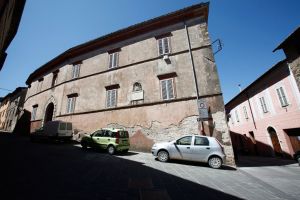The Co-cathedral of the SS. Salvatore in Montalcino
Bishop's Palace
Coming back up Via Spagni, on the right is the Bishop’s Palace.
The Palazzo Vescovile was built at the behest of Pope Pius III, born a Piccolomini (1439-1503), to give the bishop of the diocese of Pienza and Montalcino a residence at Montalcino. Despite his intentions, however, the building was only inhabited in the seventeenth century when Pienza and Montalcino became two separate dioceses. From the time the diocese was created in 1462 and throughout the sixteenth century, the bishops lived in Pienza (the village of Corsignano raised to the rank of a city by Pope Pius II) by virtue of belonging to the Piccolomini family. The palace in Montalcino was the home of the bishop until the death of Monsignor Ireneo Chelucci (1882-1970), the last bishop of the diocese of Montalcino. After this diocese was joined with the dioceses of Siena and Colle di Val d’Elsa, the bishop’s place housed the Diocesan Museum until 1994, when this was united with the Civic Museum to form the Civic and Diocesan Museum of Sacred Art, now housed in the former seminary and convent of Sant’Agostino.
The Palazzo Vescovile was built at the behest of Pope Pius III, born a Piccolomini (1439-1503), to give the bishop of the diocese of Pienza and Montalcino a residence at Montalcino. Despite his intentions, however, the building was only inhabited in the seventeenth century when Pienza and Montalcino became two separate dioceses. From the time the diocese was created in 1462 and throughout the sixteenth century, the bishops lived in Pienza (the village of Corsignano raised to the rank of a city by Pope Pius II) by virtue of belonging to the Piccolomini family. The palace in Montalcino was the home of the bishop until the death of Monsignor Ireneo Chelucci (1882-1970), the last bishop of the diocese of Montalcino. After this diocese was joined with the dioceses of Siena and Colle di Val d’Elsa, the bishop’s place housed the Diocesan Museum until 1994, when this was united with the Civic Museum to form the Civic and Diocesan Museum of Sacred Art, now housed in the former seminary and convent of Sant’Agostino.



